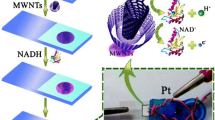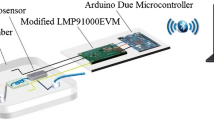Abstract
Microbiosensors for urea and adenosine triphosphate (ATP) are prepared with ion sensitive field effect transistor (ISFET) modified by enzymes such as urease and H +-ATPase respectively. The Micro-urea sensor gives a linear relationship between the initial rate of the output gate voltage change and the logarithmic value of urea concentration between 16.7 and 167 mM. Determination of urea is possible within 30 s. The optimum pH is 6.0–6.5, at 37 °C. The system can be used for 20 d with only slight loss of enzymatic activity. The micro-ATP sensor can be used for the ATP determination. A linear relationship was obtained between the initial rate of change of the differential gate output voltage and the logarithm of the ATP concentration over the range 0.2–1.0 mM ATP-sensing system exhibited a response to 1 mM ATP for at least 18 d.
Access this chapter
Tax calculation will be finalised at checkout
Purchases are for personal use only
Preview
Unable to display preview. Download preview PDF.
Similar content being viewed by others
References
H. L. Resenthal, Anal. Chem. 27, 1980 (1955)
R. L. Lemar and D. Bootzin, Anal. Chem. 29, 1233 (1957)
R. A. Lienado and G. A. Rechnitz, Anal. Chem. 4, 1109 (1974)
T. Matsuo and M. Esashi, Sens. Actuators 1, 11 (1981)
T. Bucher, Biochim. Biophys. Acta 292 (1947)
M. Deluca, in (A. Meister, Ed.), Advances in Enzymology, Wiley, New York 44, 37 (1976)
L. J. Blum, P. R. Coulet and D. C. Gautheron, Biotech. Bioeng. 27, 232 (1985)
M. Yoshida, N. Sone, H. Hirata and Y. Kagawa, J. Biol. Chem. 250, 7910 (1975)
M. Yoshida, N. Sone, H. Hirata and Y. Kagawa, J. Biol. Chem. 252, 3480 (1977)
T. Hamamoto, K. Ohno and Y. Kagawa, J. Biochem. 91, 1759 (1982)
Y. Kagawa, J. Biochem. 95, 295 (1984)
Y. Miyahara, F. Matsu, T. Moriizumi, H. Matsuoka, I. Karube and S. Suzuki, in T. Seiyama, K. Fueki, J. Shiokawa and S. Suzuki (Eds.), Chemical Sensory, Kodansha, Tokyo, Elsevier, Amsterdam, p. 513, 1983
Author information
Authors and Affiliations
Editor information
Editors and Affiliations
Rights and permissions
Copyright information
© 1989 Springer-Verlag Berlin Heidelberg
About this paper
Cite this paper
Karube, I., Tamiya, E. (1989). Microbiosensors for Clinical and Process Analysis. In: Fiechter, A., Okada, H., Tanner, R.D. (eds) Bioproducts and Bioprocesses. Springer, Berlin, Heidelberg. https://doi.org/10.1007/978-3-642-74227-9_27
Download citation
DOI: https://doi.org/10.1007/978-3-642-74227-9_27
Publisher Name: Springer, Berlin, Heidelberg
Print ISBN: 978-3-642-74229-3
Online ISBN: 978-3-642-74227-9
eBook Packages: Springer Book Archive




